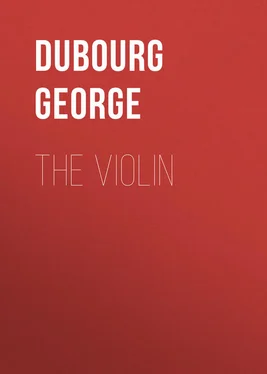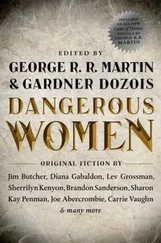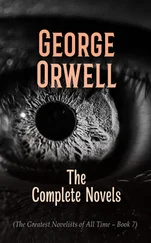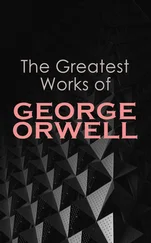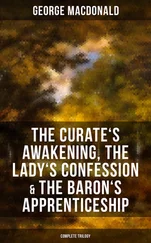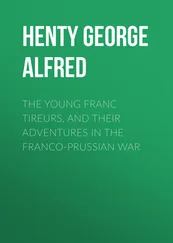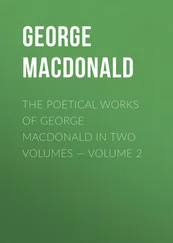George Dubourg - The Violin
Здесь есть возможность читать онлайн «George Dubourg - The Violin» — ознакомительный отрывок электронной книги совершенно бесплатно, а после прочтения отрывка купить полную версию. В некоторых случаях можно слушать аудио, скачать через торрент в формате fb2 и присутствует краткое содержание. Жанр: foreign_antique, foreign_prose, на английском языке. Описание произведения, (предисловие) а так же отзывы посетителей доступны на портале библиотеки ЛибКат.
- Название:The Violin
- Автор:
- Жанр:
- Год:неизвестен
- ISBN:нет данных
- Рейтинг книги:5 / 5. Голосов: 1
-
Избранное:Добавить в избранное
- Отзывы:
-
Ваша оценка:
- 100
- 1
- 2
- 3
- 4
- 5
The Violin: краткое содержание, описание и аннотация
Предлагаем к чтению аннотацию, описание, краткое содержание или предисловие (зависит от того, что написал сам автор книги «The Violin»). Если вы не нашли необходимую информацию о книге — напишите в комментариях, мы постараемся отыскать её.
The Violin — читать онлайн ознакомительный отрывок
Ниже представлен текст книги, разбитый по страницам. Система сохранения места последней прочитанной страницы, позволяет с удобством читать онлайн бесплатно книгу «The Violin», без необходимости каждый раз заново искать на чём Вы остановились. Поставьте закладку, и сможете в любой момент перейти на страницу, на которой закончили чтение.
Интервал:
Закладка:
George Dubourg
The Violin / Some Account of That Leading Instrument and Its Most Eminent Professors, from Its Earliest Date to the Present Time; with Hints to Amateurs, Anecdotes, etc
PREFACE TO THE PRESENT EDITION
After a lapse of nearly sixteen years since this little work first appeared in print, I have been called upon to prepare it anew for the press, incorporating with it the additional matter necessary for the extension of the subject to the present time.
My new readers may like to know, at the outset, what is the intended scope of the following pages. This is soon explained. My object has been to present to the cultivators of the Violin, whether students or proficients, such a sketch (however slight) of the rise and progress of that instrument, accompanied with particulars concerning its more prominent professors, and with incidental anecdotes, as might help to enliven their interest in it, and a little to enlarge what may be called their circumstantial acquaintance with it. This humble object has not been altogether, I trust, without its accomplishment; – and here, while commending my renovated manual to the indulgent notice of the now happily increasing community of violin votaries, I would not forget to acknowledge, gratefully, the liberal and generous appreciation with which, when it first ventured forth, it was met by the public press, and introduced into musical society.
G. D. Brighton, August, 1852.CHAPTER I
ORIGINAL AND EARLY HISTORY OF THE VIOLIN
First seat him somewhere, and derive his race. —
Dryden.The Fiddle Family, like other tribes that have succeeded in making a noise in the world, has given exercise to the ingenuity of learned theorists and time-seekers, who have laboured to discover for it an origin as remote from our own era, as it is, I fear, from any kind of truth. It has probably been conceived that the Fiddle, associated as he has been, from generation to generation, with jigs, country-dances, fairs, junketings and other rusticities, had descended too low in the scale of society – that he had rendered himself, as Shakspeare for a while did his own genius, “stale and cheap to vulgar company” – and that he required to be reminded of his primitive dignity, and of his very high ancestral derivation – if he had any . This latter point was of course to be first established; but, as your zealous antiquary is a wholesale dealer in time, and is never at a loss for a few centuries to link his conjectures to, the matter was easy enough; indeed, the more doubtful, the better, since doubt is the very life of theory. Accordingly, we have been invited to fall back upon “the ancients,” and to recognize the Epigonion as the dignified and classic prototype of our merry and somewhat lax little friend, the Fiddle. To certain ancient Greek tablets relative to music, which have been somewhere brought to light, Professor Murchard has minutely assigned the date of 709 years before the Christian era; and the following passage, Englished from his translation, is stoutly alleged by the antiquarian advocates of the glories of the violin race: – “But Pherekydes began the contest, and sat himself down before all the people, and played the Epigonion ; – for he had improved the same; and he stretched four strings over a small piece of wood, and played on them with a smooth stick. But the strings sounded so, that the people shouted with joy.”
This is plausible enough, but far from conclusive. It is but the outline of a description, and admits of various modes of filling up. If the instrument partook at all of the violin character, it might seem, from the reference which its name bears to the knees , to have been the rude progenitor of either the double-bass or the violoncello, which have both, as is well known, their official post between the knees: but then, the prefix of ἐπί would denote that it was played upon the knees of the artist. “Very well,” says the antiquarian; “it was a fiddle reversed .” “Nay, Dr. Dryasdust, if you yourself overturn what you are about, I have no need to say more.” Au reste , let any body stretch four strings over a small piece of wood, and play on them with a smooth stick, and then take account of what it comes to. No, no; whatever the Epigonion may have been to the Greeks, he is nothing to us : he may have been a respectable individual of the musical genus of his day, when people blew a shell or a reed, and called it music; but we cannot for a moment receive him as the patriarch of the Fiddle Family. As soon should we think of setting up Pherekydes against Paganini.
Dismissing the Epigonion, we come to the Semicon , another pretender of Greek origin. This also, we are farther told, was a kind of violin : but we deny that he was father to the violin kind . The Semicon is said to have been played on with a bow; and yet a learned German (Koch), in the fulness of his determination to have strings enough to his bow, has claimed no less than thirty-five, as the complement of the Semicon. How could any bow pay its devoirs distinctly to thirty-five strings? Here, then, the dilemma is this: either to translate the thing in question into a bow is to traduce the term, or else the strings are an impertinence. Utrum horum mavis, accipe.
If the word plectrum could, by any ingenuity, be established to mean a bow , quotations enough might be accumulated to prove that instruments played with bows had their origin in a very remote period. But the translation of the word into a bow, or such like thing , as we find it in the Dictionaries, arises simply from the want of a known equivalent – a deficiency which makes it necessary to adopt any term that offers even the shadow of a synonym.
It has been stated, on the authority of a passage from Euphorion’s book on the Isthmian Games, that there was an ancient instrument called magadis , which was surrounded by strings; that it was placed upon a pivot, upon which it turned, whilst the performer touched it with the bow (or, at least, the plectrum ); and that this instrument afterwards received the name of sambuce .
The hieroglyphics of Peter Valerian, page 628, chap. 4, present the figure of a muse, holding, in her right hand, a kind of bass or contra-violin, the form of which is not very unlike that of our violins or basses.
Philostratus, moreover, who taught at Athens, during the reign of Nero, gives a description of the lyre, which has been thus translated: —
“Orpheus,” he says, “supported the lyre against his left leg, whilst he beat time by striking his foot upon the ground; in his right hand he held the bow , which he drew across the strings, turning his wrist slightly inwards. He touched the strings with the fingers of his left hand, keeping the knuckles perfectly straight.”
From this description (if bow it could be called, which bow was none), it would appear as if the lyre to which Philostratus alludes were, forsooth, the same instrument which the moderns call the contra-violin , or viola di gamba ! To settle the matter thus, however, would be indeed to beg the question.
As before observed, the word plectrum is, in the dictionaries, translated by bow ; but, even if this were a warranted rendering of the word, it remains to be ascertained not only whether the bows of the ancients were of a form and nature corresponding with ours, but also whether they were used in the modern way . Did the ancients strike their bow upon the strings of the instrument – or did they draw forth the sound by means of friction? These questions are still undecided; but opinions preponderate greatly in favor of the belief that the plectrum was an implement of percussion , and therefore not at all a bow, in our sense.
Читать дальшеИнтервал:
Закладка:
Похожие книги на «The Violin»
Представляем Вашему вниманию похожие книги на «The Violin» списком для выбора. Мы отобрали схожую по названию и смыслу литературу в надежде предоставить читателям больше вариантов отыскать новые, интересные, ещё непрочитанные произведения.
Обсуждение, отзывы о книге «The Violin» и просто собственные мнения читателей. Оставьте ваши комментарии, напишите, что Вы думаете о произведении, его смысле или главных героях. Укажите что конкретно понравилось, а что нет, и почему Вы так считаете.
